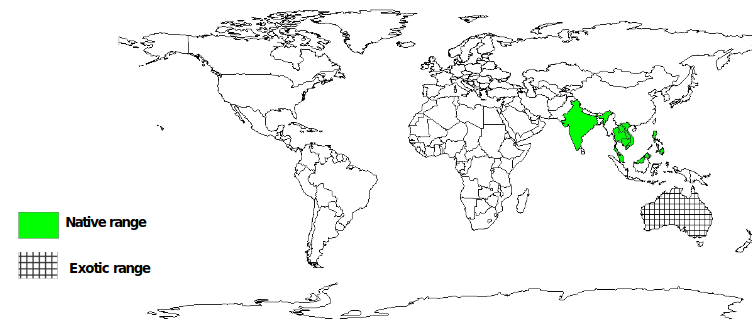Publication
from Agroforestree Database: a tree reference and selection guide version 4.0
by C. Orwa, A. Mutua, R. Kindt, R. Jamnadass and S. Anthony
Sandoricum koetjape (Burm. f.) Merr.
Local Names: Burmese (thitto);
English (sentol, santol, kechapi); Filipino (malasantol); French (faux
mangoustan); Indonesian (sentul, kecapi, ketuat); Khmer (kôm piing
riech); Lao (Sino-Tibetan) (tong, toongz); Malay
(kecapi, kelampu, ranggu); Thai (kra thon, sa thon, katon, ma tong);
Vietnamese (s[aa][us]-dan, s[aa][us]-dau,sâú)
Family: Meliaceae
Botanic Description
Sandoricum koetjape is
a deciduous, small to large tree, up to 45(-50) m tall. The tree bole
is sometimes straight but often crooked or fluted, branchless for up to
18(-21) m and with a trunk diameter up to 100 cm. Buttresses up to 3m
high. Bark surface smooth or sometimes flaky or fissured, lenticillate,
greyish to pale pinkish-brown, inner bark pale brown or red-brown to
pink, exuding a milky latex. The tree is interesting because it
branches unusually low to the ground but has a compact crown.
Leaves trifoliate arranged spirally, exstipulate; leaflets entire.
Flowers
in an axillary thyrse, bisexual, 4-5 merous; calyx truncate to
shallowly lobed; petals free; staminal tube cylindrical, carrying 10
anthers; disk tubular; ovary superior, 4-5-locular with 2 ovules in
each cell, stylehead lobed.
Fruit a 1-5-locular drupe about the size of
a clenched fist; pyrenes 1(-2)- seeded. Seed large, without aril and
surrounded by a translucent or pale, acid, edible pulp of good flavour.
S. koetjape
is a highly variable species and was formerly divided into 2 or 3
species based on the colour of the old leaves, however there appears to
be no correlation with other characters and this distinction has been
dropped.
Biology
Santol
is a hermaphroditic tree flowering after 5-7 years (clonally propagated
trees may flower after 3-4 years). Pollination is by insects. Flowers
annually and in Peninsular Malaysia the flowering period is so reliable
in its timing that it was formerly the signal for the planting of rice.
New leaves develop rapidly and flowers appear shortly after the
development of new shoots. Fruit maturation takes about 5 months. In
the Philippines ripe fruits are present from June-October, and in
Thailand from May-July. Bats disperse the seeds.
Ecology
S. koetjape is found scattered in primary or sometimes secondary rain forest. It also occurs in lowland dipterocarp forest.
Biophysical Limits
Altitude: 0-800 m
Soil type: Prefers podzolic soils in both perhumid and seasonal climates.
Documented Species Distribution
Native: Brunei, Cambodia, India, Laos, Malaysia, Myanmar, Philippines, Thailand, Vietnam
Exotic: Australia, Sri Lanka

The map above shows countries where the species has been planted.
It does neither suggest that the species can be planted in every
ecological zone within that country, nor that the species can not be
planted in other countries than those depicted. Since some tree species
are invasive, you need to follow biosafety procedures that apply to
your planting site.
Products
Food:
The fruit is edible, being eaten fresh or processed into jam or
chutney. The fruit is peeled, quartered and cooked in syrup to make
delicious preserves.
Timber:
S. koetjape yields a lightweight to medium-weight hardwood with a
density of 290-590 kg/m³ at 15% moisture content. Heartwood is
pale red, yellowish-red or yellow-brown with a pink tinge, indistinct
or distinguishable from the pale white or pinkish sapwood; grain
straight or slightly wavy.
Tannin or dyestuff: The bark is used for tanning fishing nets.
Poison: The seeds of S. koetjape
contain limonoids (antifeedant compounds).
Medicine: The pounded leaves
are sudorific when applied to the skin and are used to make a decoction
against diarrhoea and fever. The powdered bark is an effective
treatment for ringworms, and contains triterpenes with anticancer
activity. The aromatic roots are employed as an anti-diarrhetic,
anti-spasmodic, carminative, antiseptic, astringent, stomachic and are
prescribed as a general tonic after childbirth.
Other products: The fruits are used as fish bait in Sarawak. The fragrant wood is used in perfumery.
Services
Erosion control: The tree is important in soil conservation.
Shade or shelter: It gives an excellent shade.
Reclamation: The species is hardy and thrives without irrigation in areas with a prolonged dry season.
Soil improver: S. koetjape is known to form vesicular arbiscular mycorrhizae.
Ornamental: S.koetjape is planted for aesthetic purposes along avenues and in parks.
Boundary or barrier or support: Poles from the tree are used for fencing.
Tree Management
Seedling growth is fast.
Germplasm Management
Seedling exhibiting epigeal germination. Seeds have short viability, and a germination rate of 90-95% in 16-31 days.
Pests and Diseases
The sapwood is susceptible to Lyctus. The wood is susceptible to marine borer attack and moderately resistant to insect attack.
Further Reading
CABI. 2000. Global Forestry Compendium. CD-ROM. CABI
Sosef
MSM, Hong LT, Prawirohatmodjo S. (eds.). 1998. PROSEA 5(3) Timber
trees: lesser known species. Backhuys Publishers, Leiden.
|
|